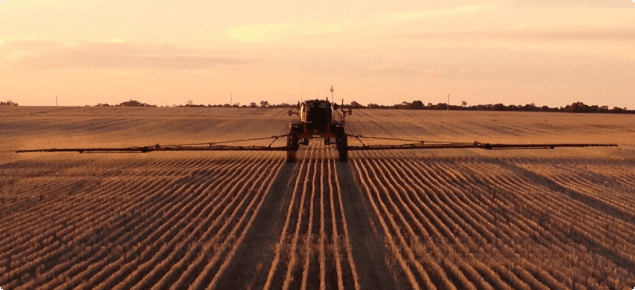
Restricting farm machinery movements to permanent wheeltracks under controlled traffic farming, such as in this scene of a sprayer operating on a farm in WA, is the best way to manage soil compaction, even for lightweight robotic machines. (Photo: DPIRD)
DESPITE the claims of robotic machinery proponents, lightweight machines do cause soil compaction and therefore should be operated on the permanent wheeltracks of controlled traffic farming systems, according to University of Tasmania agricultural engineer, John McPhee.
Speaking at the Controlled Traffic Farming (CTF) conference in Ballarat, Victoria, Mr McPhee said he disagreed with the proposition by sectors of the robotics industry that lightweight, autonomous machines were a means of managing soil compaction.
“The point I attempt to counter is the claim made in some autonomous machinery magazines and articles that using lightweight machines ‘eliminates’ soil compaction,” he said.
“I think where the argument falls over is that people are saying if they drive 20 to 40-tonne machines around a paddock they will create soil compaction, but if they drive a 4.5-tonne machine around a paddock they won’t create as much soil compaction.
“That might be obvious, but what they are not doing is comparing what happens if you go onto a soil which has had no soil compaction – in other words, a soil that has been managed under controlled traffic.
“An analysis of the level of soil compaction that occurs with a lightweight, 4.5-tonne, fully loaded grain harvester showed soil compaction was still very significant, going down to depths of 30 to 50 centimetres.”
Mr McPhee said the soil compaction created might or might not be economically significant – “in some cases it might not be, in other cases it most definitely will be” – but it certainly was damaging to the soil.
“The point is we achieve soil properties under controlled traffic which will be negatively impacted by lightweight machines,” he said.
“So, let’s not get hung up about lightweight machines being the solution to soil compaction. Let’s maybe use medium-weight autonomous machines and put them on a controlled traffic system.
“The two main selling points for autonomous machines are saving labour and redundancy – that is, if you have 10 small machines instead of one big one, you can have one small machine break down and you still have 90 per cent of your capacity. Where you have one big machine and it breaks down you have nothing.
“So, why impose a rather severe design constraint on autonomous machines, such as avoiding soil compaction, when we could use sensibly-sized machinery on controlled traffic. You could put three or four medium-sized autonomous machines in a paddock and you still get the labour saving and a level of redundancy, and if you put them on controlled traffic the soil compaction problem is managed.”
Mr McPhee said running a system of lightweight machines, such as 4.5-tonne harvesters, came with a host of logistical challenges.
“As an indicator, a 4.5-tonne machine would have a bin capacity of roughly a cubic metre, a cut width of a little under two metres and would probably have a 40 to 50kW engine,” he said.
“Logistically, running 4.5-tonne autonomous harvesters, you would need something like six to eight of them to replace one modern-day harvester. They would fill up every eight to 12 minutes, so within the group of harvesters one of them would need to be unloading about every minute and a half.
“So, the long and short of it is, let’s not try to solve soil compaction with lightweight robotic machines. Let robotics do the things robotics do well, but put them into a machinery family that has decent capacity and can be managed under a controlled traffic system. Therefore you get your soil benefits and you get the automation benefits.”
Grain Central: Get our free cropping news straight to your inbox – Click here


HAVE YOUR SAY